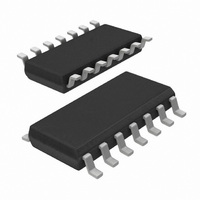74HC7014D,112 NXP Semiconductors, 74HC7014D,112 Datasheet - Page 8

74HC7014D,112
Manufacturer Part Number
74HC7014D,112
Description
IC BUFF/DVR SCHM TRG 6BIT 14SOIC
Manufacturer
NXP Semiconductors
Series
74HCr
Datasheet
1.74HC7014N112.pdf
(9 pages)
Specifications of 74HC7014D,112
Logic Type
Schmitt Trigger - Buffer, Driver
Package / Case
14-SOIC (3.9mm Width), 14-SOL
Number Of Elements
6
Number Of Bits Per Element
1
Current - Output High, Low
5.2mA, 5.2mA
Voltage - Supply
2 V ~ 6 V
Operating Temperature
-40°C ~ 125°C
Mounting Type
Surface Mount
Logic Family
74HC
Number Of Channels Per Chip
6
Polarity
Non-Inverting
Supply Voltage (max)
6 V
Supply Voltage (min)
2 V
Maximum Operating Temperature
125 C
Mounting Style
SMD/SMT
High Level Output Current
- 5.2 mA
Input Bias Current (max)
2 uA
Low Level Output Current
5.2 mA
Maximum Power Dissipation
500 mW
Minimum Operating Temperature
- 40 C
Propagation Delay Time
175 ns
Number Of Lines (input / Output)
6 / 6
Logical Function
Schmit Trig Buffer
Number Of Elements
6
Number Of Channels
6
Number Of Inputs
6
Number Of Outputs
6
Operating Supply Voltage (typ)
5V
Package Type
SO
Operating Supply Voltage (max)
6V
Operating Supply Voltage (min)
2V
Quiescent Current
2uA
Technology
CMOS
Pin Count
14
Mounting
Surface Mount
Operating Temp Range
-40C to 125C
Operating Temperature Classification
Automotive
Lead Free Status / RoHS Status
Lead free / RoHS Compliant
Lead Free Status / RoHS Status
Lead free / RoHS Compliant, Lead free / RoHS Compliant
Other names
568-1488-5
74HC7014D
935059840112
74HC7014D
935059840112
Philips Semiconductors
SOLDERING
Introduction
There is no soldering method that is ideal for all IC
packages. Wave soldering is often preferred when
through-hole and surface mounted components are mixed
on one printed-circuit board. However, wave soldering is
not always suitable for surface mounted ICs, or for
printed-circuits with high population densities. In these
situations reflow soldering is often used.
This text gives a very brief insight to a complex technology.
A more in-depth account of soldering ICs can be found in
our “Data Handbook IC26; Integrated Circuit Packages”
(order code 9398 652 90011).
DIP
S
The maximum permissible temperature of the solder is
260 C; solder at this temperature must not be in contact
with the joint for more than 5 seconds. The total contact
time of successive solder waves must not exceed
5 seconds.
The device may be mounted up to the seating plane, but
the temperature of the plastic body must not exceed the
specified maximum storage temperature (T
printed-circuit board has been pre-heated, forced cooling
may be necessary immediately after soldering to keep the
temperature within the permissible limit.
R
Apply a low voltage soldering iron (less than 24 V) to the
lead(s) of the package, below the seating plane or not
more than 2 mm above it. If the temperature of the
soldering iron bit is less than 300 C it may remain in
contact for up to 10 seconds. If the bit temperature is
between 300 and 400 C, contact may be up to 5 seconds.
SO
R
Reflow soldering techniques are suitable for all SO
packages.
Reflow soldering requires solder paste (a suspension of
fine solder particles, flux and binding agent) to be applied
to the printed-circuit board by screen printing, stencilling or
pressure-syringe dispensing before package placement.
1998 Jul 08
OLDERING BY DIPPING OR BY WAVE
EPAIRING SOLDERED JOINTS
EFLOW SOLDERING
Hex non-inverting precision Schmitt-trigger
stg max
). If the
8
Several techniques exist for reflowing; for example,
thermal conduction by heated belt. Dwell times vary
between 50 and 300 seconds depending on heating
method. Typical reflow temperatures range from
215 to 250 C.
Preheating is necessary to dry the paste and evaporate
the binding agent. Preheating duration: 45 minutes at
45 C.
W
Wave soldering techniques can be used for all SO
packages if the following conditions are observed:
During placement and before soldering, the package must
be fixed with a droplet of adhesive. The adhesive can be
applied by screen printing, pin transfer or syringe
dispensing. The package can be soldered after the
adhesive is cured.
Maximum permissible solder temperature is 260 C, and
maximum duration of package immersion in solder is
10 seconds, if cooled to less than 150 C within
6 seconds. Typical dwell time is 4 seconds at 250 C.
A mildly-activated flux will eliminate the need for removal
of corrosive residues in most applications.
R
Fix the component by first soldering two diagonally-
opposite end leads. Use only a low voltage soldering iron
(less than 24 V) applied to the flat part of the lead. Contact
time must be limited to 10 seconds at up to 300 C. When
using a dedicated tool, all other leads can be soldered in
one operation within 2 to 5 seconds between
270 and 320 C.
EPAIRING SOLDERED JOINTS
AVE SOLDERING
A double-wave (a turbulent wave with high upward
pressure followed by a smooth laminar wave) soldering
technique should be used.
The longitudinal axis of the package footprint must be
parallel to the solder flow.
The package footprint must incorporate solder thieves at
the downstream end.
Product specification
74HC7014












